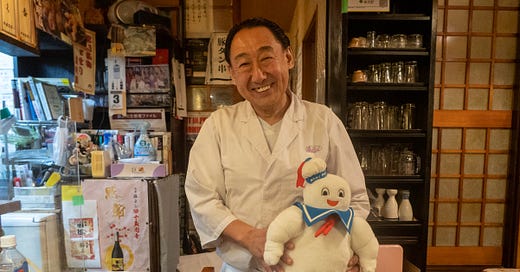During my weeks in Dakar and Jakarta, when things would get a little rough, which they did a lot, I kept looking forward to ending my trip in Japan. I hadn’t been since I was a boy, way back in the ‘70s1, but I’d long admired Japanese culture, or what had made it to the US. Especially the food.
I was also looking forward to being in a place that worked, at every level, so when I landed at Haneda Airport, even though it was close to ten p.m., I had happy images in my head of soon being in an izakaya sipping Sapporro and eating grilled stuff on a stick.
That didn’t happen, at least not the first night, because while Japan works at every level, it doesn’t work at every time. Certainly not after eleven p.m., when Tokyo’s otherwise amazing bus and rail system shuts down.
The polite young woman working at the information desk explained exactly how stuck I was when I asked if I could take the snazzy sounding monorail into town, and she said “No. It is closed for night.” Ditto for the Keikyu line trains. Ditto for the buses. When I said, “So, I’m stuck?” she pointed outside at the three hundred plus mob waiting for a taxi. When I explained that I’d already been out there for ten minutes, and had seen only maybe five taxis she smiled, apologized many times, and bowed even more times.
Always polite, even in failure.
So that night I didn’t get to eat in my dream izakaya. Instead I grabbed a few pre-packaged sandwiches from the NewDays2 , found a corner, and slept badly until the system came online again at five a.m. On the plus side, it was a pretty high-class sleeping-in-public experience, since everything around me was super clean, super quiet, and super safe.
My izakaya dreams did come true twenty hours later, and it was even better than I’d imagined, but not before more frustration, this time about money.
In Japan cash is still king, a result of so many restaurants and stores being family-run businesses, but getting cash as a foreigner isn’t easy, not if you hate paying absurd fees, which is what the ATMs in the convenience stores charge you.
That first night I hadn’t yet discovered how to get cash3, so I was walking around with the last of my cash from the airport, just three one-thousand Yen notes, or roughly twenty dollars, and desperate to be frugal with it, but also really really wanting to finally eat in an izakaya.
Which is how I chose Morihito’s Tokyo izakaya, or how it chose me actually. When I went to see if maybe by some small chance the dimly lit nameless place in the middle of the street accepted credit cards (no way), I triggered the automatic sliding door, which swooshed open, bringing Morihito to his feet with a huge smile, many bows, and lots of poetic sounding words urging me inside.
I couldn’t decline, because what type of person turns down a huge smile, and so I entered into the small space, sat at the counter, and was quickly given cold green tea, a warm towel, and a dish of tofu covered in all sorts of flavors.
Izakaya literally means stay-drink-place, and that is what I did that night. I stayed and drank in Morihito’s place, and it really felt like his place. More his home than his business, complete with loads of family photos lining the walls and counter. It was cluttered, but in a very Japanese way. Meaning, cluttered and yet clean.
I was, at first, the only customer there, and by the looks of it, I thought I might have been the only person who’d been there all week, or all month, and I started to wonder what I had gotten myself into.




